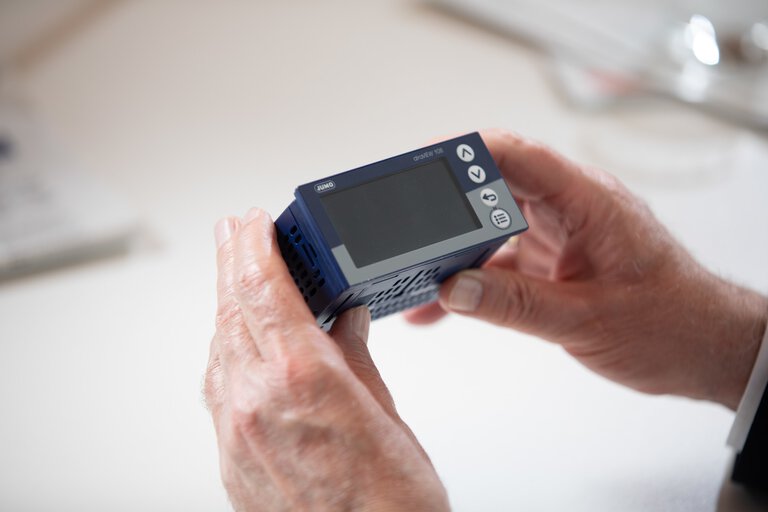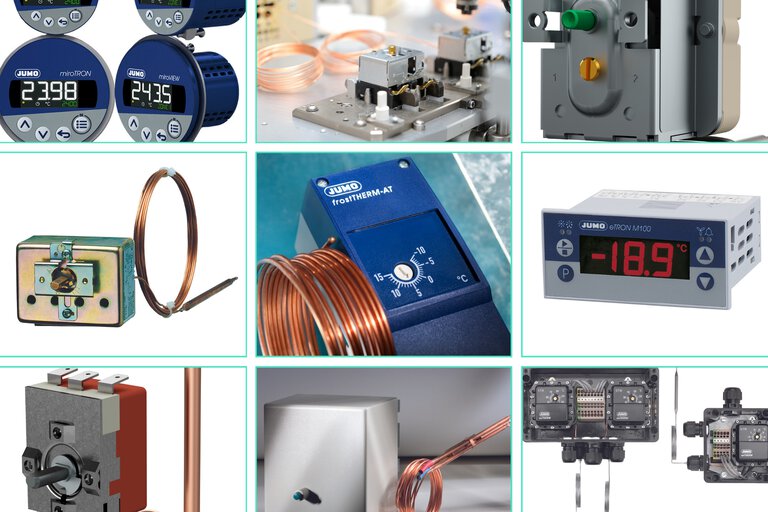
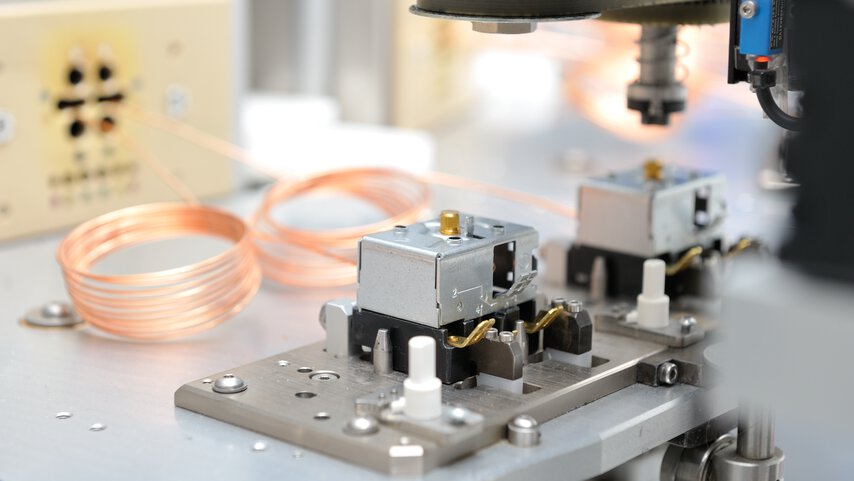
How to choose an industrial thermostat? Practical tips
An industrial thermostat is an indispensable device in the precise temperature management of various processes. In this blog post, we discuss key aspects of these devices: their types, applications, and factors that determine their selection. You'll learn how these temperature controllers affect operational efficiency and safety in industry, and how to properly match a thermostat to the specific needs of your application. We invite you to explore the topic in depth!
What is an industrial thermostat?
An industrial thermostat is a device used to monitor and regulate temperature in a variety of industrial applications. Its main components are contacts that open or close an electrical circuit depending on the temperature. This, in turn, activates or deactivates heating or cooling systems to maintain a set temperature. Thermostats are used in a variety of industries, including chemical, food, pharmaceutical, as well as HVAC (heating, ventilation, air conditioning) systems.
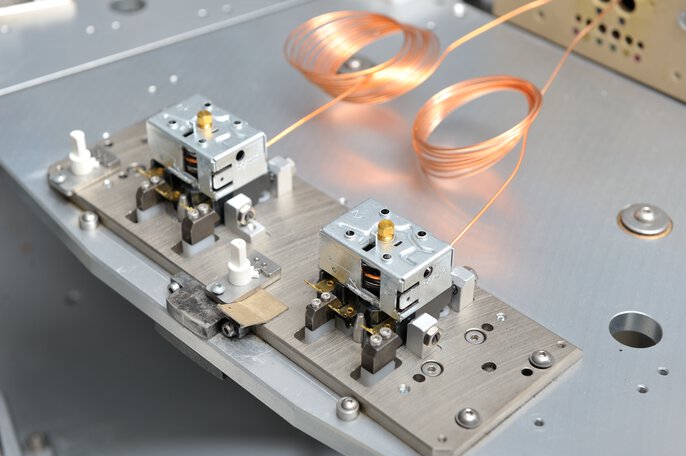
Production of industrial thermostats at JUMO
Types of Temperature Control Regulators
In the industrial world, there is a multitude of thermostats, each designed with specific requirements and applications in mind. It is crucial to understand the differences between them to make an informed choice of the optimal device. The classification of thermostats is mainly based on the type of control and mounting, as well as their dedicated application.
Types of thermostats based on the type of control:
- Mechanical Thermostats: These classic devices, such as the JUMO heatTHERM P300, operate on the principle of material expansion and contraction due to temperature changes. They are simple, reliable, and their independence from electrical power makes them ideal for basic industrial applications where only general temperature regulation is needed.
- Electronic Thermostats: Utilize advanced technologies for precise monitoring and temperature regulation. They are more accurate than mechanical models and often have additional features such as programming, remote reading, or alarms. For example, the eTRON M100 model represents this type of thermostat, offering advanced options for applications requiring precise control.
- Digital Thermostats with PID Algorithm: These devices employ an advanced form of temperature control, combining proportional, integral, and derivative control methods. As a result, they provide very precise maintenance of the set temperature, minimizing fluctuations around the target value. An example of such temperature sensors is the JUMO miroTRON series.

Series of electronic thermostats with optional PID controller function miroTRON
Types of thermostats by mounting:
- Wall-mounted thermostats: Often mounted on walls, ideal for warehouses, production halls and other large spaces, e.g. JUMO ATH in a damage-resistant housing.
- Panel-mount thermostats: Built into control panels of equipment or systems, such as HVAC, or into control cabinets. Examples of such devices are the dual limiting / safety / control thermostats of the JUMO heatTHERM-AT / heatTHERM-DR series.
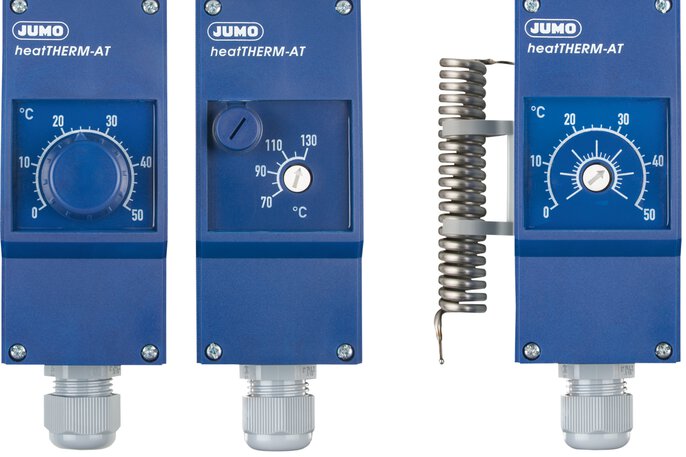
JUMO heatTHERM-AT / heatTHERM-DR thermostats for control cabinets
Types of thermostats by application:
- Specialized models, such as antifreeze thermostats such as JUMO frostTHERM-AT/DR or those dedicated to the shipbuilding industry such as JUMO ATH.-SE, are tailored to the specific requirements of these unique environments.
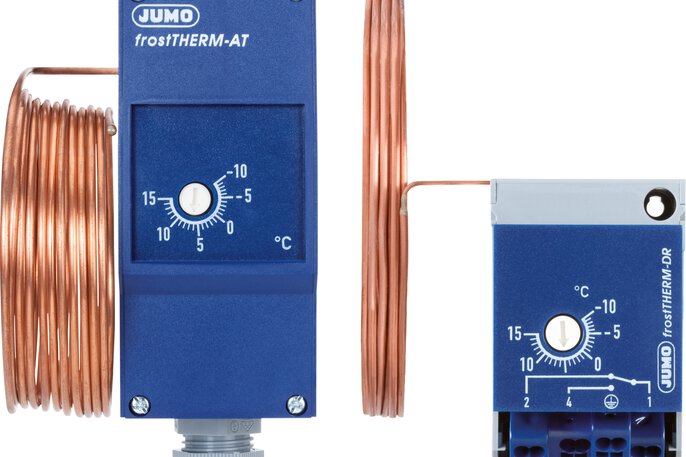
JUMO frostTHERM-AT/DR universal antifreeze thermostats
Industrial Thermostat Selection Criteria
Choosing an industrial thermostat is a critical element in ensuring efficiency and safety in technological processes where proper temperature control is crucial. In practice, apart from understanding the technical specifications, a deep understanding of the processes in which the thermostat will be used is also important. Here are the detailed criteria to consider when selecting:
- Temperature Range: The thermostat must have a temperature range suitable for the needs of the process. For example, in the chemical industry, precise temperature control of reactions is crucial - here, thermostats with a PID algorithm may offer the best precision due to their ability to finely adjust temperature.
- Measurement Accuracy: In some applications, such as the production of pharmaceuticals, very high accuracy is required. In such cases, thermostats with advanced sensors and calibration capabilities are appropriate.
- Type of Control: Depending on the environment, different types of control may be more suitable. For example, in environments with high dust or humidity, simple mechanical thermostats may be more reliable and resistant to damage than more complex electronic thermostats.
- Application: Thermostats for HVAC systems must be able to not only control temperature but also interact with other elements of the system, such as fans or air conditioning systems. Thermostats with integrated communication functions for central control systems may be required.
- Mounting Method: The choice of mounting method depends on the location of the thermostat installation. For example, in tight spaces such as control cabinets, compact panel-mounted thermostats are more preferred.
- Additional Features: Options such as remote control, time programming, alarms, or communication interfaces can significantly increase the functionality of the thermostat. For example, in large manufacturing plants, remote monitoring and alarms can help respond quickly to temperature anomalies.
- Price: Of course, the budget is an important factor. It is necessary to find a balance between the required features and available resources.
- Resistance to Environmental Conditions: Thermostats can be exposed to extreme conditions, such as humidity, dust, chemicals, or vibrations. Depending on the working environment, choosing a thermostat resistant to these conditions may be key.
- Ease of Use and Service Availability: When choosing a thermostat, consider how easy it is to use and maintain the device and how quickly and easily service support can be obtained in case of failure.
About the author
My name is Ewelina Szmit and I have been working in the field of content marketing for several years, combining my professional skills with my passion for writing. I believe that even the most technical topics can be presented in an interesting and accessible way for everyone. Outside of work, I develop my creativity by creating newspaper collages. I like to spend my free time most actively, walking my dog or running.

Technical specialist
Jakub Dąbrowski - Inside Sales Engineer +48882351471 Jakub.Dabrowski@JUMO.net +48882351471Comments
We encourage you to leave your comments via the form below. They will be posted online after they have been approved through our review process.

